한식 읽기 좋은 날
Vol 41. Cold Nourishing Food
Healthy and Cool Summer Taste in Old Books
“Cold flavor” from cold food and dishes made with cool food ingredients is something that cannot be excluded on the summer table. The skill of our ancestors in creating summer food that protected their health by reviving their lost appetite and cooling down their body during summer is preserved in the old books.
Sources and references. 《Joseon Moosang Sinsik Yori Jebeop(by Lee Yonggi, Rice Tree)
Korean Traditional Knowledge Portal(www.koreantk.com)
Encyclopedia of Korean Culture
Naengguk, a Fine Taste Discovered in Summer
“The taste is upright so the daily meal is vulgar(in comparison).” The dish that Yi Gyubo from Koryo Dynasty praised like this is “soongaeng”. <Joseon Yoribeop>(1939) written by Cho Jahoh states, “Changguk is recommended in summer when you have no appetite”. “Soongaeng” and “changguk” here are naengguk(chilled soup). <Joseon Moosang Sinsik Yori Jebeop>(1924) written by Lee Yonggi states, “Changguk is changuk(cold soup) eaten during summer. There is nothing other than cheonggukmyeon to eat cold during winter, and this is different from naengmyeon.”
Naengguk made by adding vegetables as geonji(bits of solid meat and vegetable ingredients) and seasoning with soy sauce, oil, and vinegar into chilled soup and soy sauce-water is an ideal dish for the summer table with its cool, refreshing, and fine taste. A variety of naengguk is made depending on the types of geonji added to it and <Joseon Moosang Sinsik Yori Jebeop> cites “Oechangguk” as the best.
Oechangguk
Main ingredients Cucumber, ganjang(soy sauce), vinegar, green onion, jachongi(spicier type of green onion), and gochutgaru(red chili pepper powder)
How to make it 1
① Wash young cucumbers, remove the stems, and cut them into thin strips.
② Cut the green onion and jachongi into thin strips, and mix with the ganjang(soy sauce) and vinegar.
③ Sprinkle red chili powder and marinate for 1 to 2 hours. Add water to adjust the seasoning before eating.
④ It tastes the best among changguk dishes when eaten with a lot of vinegar.
How to make it 2
① Cut young cucumbers into thin strips and marinate with vinegar and various garnishes.
② When eating, add water to make the cucumber strips float.
③ It can be eaten as soup and kimchi.
photo by the Korean Food Promotion Institute
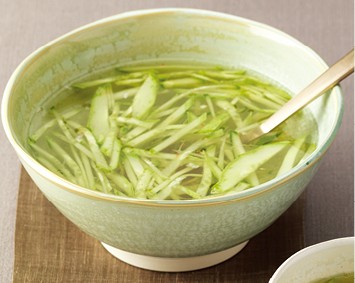
Kimchangguk
Main ingredients Kim(laver), ganjang(soy sauce), vinegar, oil, green onion, gochutgaru(red chili pepper powder), and meat
How to make it
① Remove the crumbs from the laver by rubbing it, roast it until crispy, and crumple it.
② Mix in the ganjang(soy sauce), vinegar, and oil in water, and add julienned green onion and laver.
③ The more vinegar is used, the better.
④ Sometimes only a bit of green onion is added with a sprinkle of red chili powder.
⑤ Place the meat, green onion, and oil in a bowl, knead it, stir-fry it, cool it, and add in water.
⑥ Eat it with vinegar and laver. ⑦ It is best eaten very cold.
Miyeok Changguk(Cold Seaweed Soup)
Main ingredients Seaweed, ganjang(soy sauce), oil, meat, green onion, and vinegar
How to make it
① Clean the seaweed in water, remove the stem, and tear it into small pieces. Mix in ganjang(soy sauce) and oil.
② Pound the lean meat and green onion in a pot, and k d them together. Add a bit of water, stir-fry it, and scoop it out.
③ When it cools down, add a lot of vinegar. Add water to adjust the seasoning.
Cold Flavors Found in the Palace
“Imjasutang” is considered as the best cold, nourishing dish eaten during summer. Imjasutang, which has the modifier, the royal court’s naengguk, is made by grinding sesame seeds in chilled chicken broth. It is also called “ggatguktang(sesame soup)”. Imja in imjasutang means sesame seeds. “Baekmajatang” is made with white sesame seeds. Shredded chicken, egg garnish, water parsley, cucumber strips, golden oak mushrooms, and beef meatballs are often added as garnish.
Chogyetang(cold chicken soup) is also included in the cool nourishing food.
How to Make Chogyetang
Main ingredients 1 young chicken, 2 cucumbers, 1 small abalone, 3 golden oak mushrooms, 3 sea cucumbers, 1/2 pear, 2 Tbsp pine nuts, 2 hops(1 hop = about 180 ml) sesame seeds, 2 eggs, soy sauce, a little bit of sesame salt and pepper, 1 green onion, a little bit of sesame oil, and wheat noodles
How to make it ① Remove the husks from the sesame seeds. Put a white paper in the pot, pour the sesame seeds little by little, stir-fry them, pour in the water, and sift through a sieve each time.
② Clean and boil the chicken. Slice the meat thinly and season it with various seasonings.
③ Cut the stem of the cucumber, thinly slice the skin, and cut into flat slices. Salt it lightly, rinse in water, and squeeze the water out. Add oil to a frying pan and stir-fry it lightly.
④ Soak the abalone and add it into the pot of boiling chicken. When it is cooked, take it out and cut it thinly.
⑤ Soak the golden oak mushrooms and cut them flat.
⑥ After boiling the sea cucumber, cut it in half, clean the inside, and cut it into the same size as the other ingredients.
⑦ Cut the pear into the same size.
⑧ Make a garnish with the eggs.
⑨ Put all the ingredients in a bowl, season the sesame soup in ① with salt, add small pieces of crushed ice, and float pine nuts.
⑩ Make wheat noodles and put them in.Source: 《Joseon Yoribeop》(1943)
“Summer Naengmyeon”, the Flavor of Noodles Discovered in Summer
When we say cold noodles, we immediately think about naengmyeon. <Joseon Moosang Sinsik Yori Jebeop> introduces how to make summer and winter naengmyeons, and the summer naengmyeon is different from the naengmyeon we eat during summer. Jangguk Naengmyeon in <Joseon Eumsik Mandeuneun Beop: How to Make Joseon Dishes> and Kongguk Naengmyeon in <Ijo Gooojeong Yori Tonggo: Information on Joseon Royal Court Food> are also the dishes eaten during sambok(midsummer).

(Summer Naengmyeon)Store Naengmyeon
Main ingredients Meat(chicken soup), noodles, pork, suyuk(boiled beef or pork slices), fried fish, cabbage kimchi, pear, jujube, peach, apple, pine nut, sliced boiled eggs, egg whites and yolk garnishes, stone mushroom, threaded red pepper, sugar, mustard, and vinegar
How to make it① Add freshly-made noodles in the cooled meat or chicken soup and a block of ice in the middle.
② Put pork, suyuk, fried fish, cabbage kimchi, pear, jujube, peach, apple, pine nuts, sliced boiled eggs, egg garnish, sliced stone mushroom, and threaded red pepper on the noodle. Season it with sugar, mustard, and vinegar.
③ It is not good to put a lot of ingredients. Add kimchi, pear, and pork instead of miscellaneous garnishes.
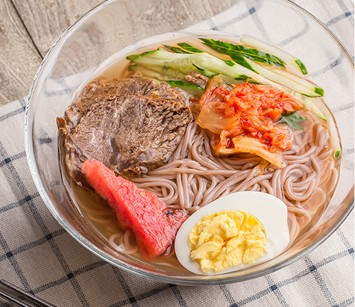
(Summer Naengmyeon)
Homemade Naengmyeon
Main ingredients Soup(sesame soup, soybean soup), cucumber, oil, goji name, sesame, meat, pine nuts, and ice
How to make it① Put noodles in soy sauce soup, sesame soup, or cold soybean soup.
② Slice the cucumbers, pickle them in salt, and fry them in oil.
③ Add sliced egg garnish, stone mushroom, chopped stir-fried meat, and pine nuts as garnish, as well as ice before eating.
④ If there is no cucumber, use water parsley.
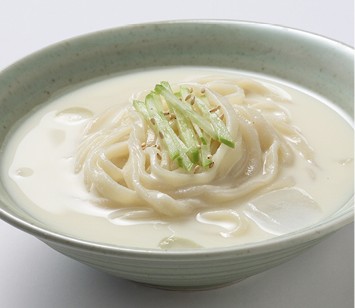
How to Make Kongguk
(Cold Soybean Soup)
Naengmyeon
Main ingredients 1 doe(=about 1.8 liter) of flour, 1 doe of beans, 2 hops(1 hop=about 180 ml) of sesame seeds, and a little bit of salt
How to make it① Wash the sesame seeds and stir-fry them carefully so they do not burn.
② Soak the soybeans in water and boil them. Grind them together with roasted sesame seeds on a millstone and sieve them. Add a little water, season with salt, and make kongguk. Allow it to cool down.
③ After kneading the flour, roll out the wheat noodles. Cook them in boiling water, rinse them in cold water, and add them to kongguk.
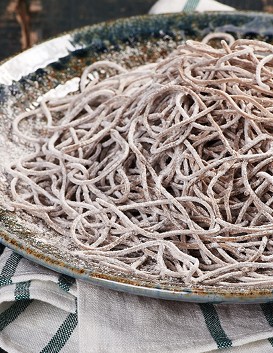
How to MakeJangguk(Soybean Soup)
Naengmyeon
Main ingredients (For 10 bowls) 10 saris(bunches) of noodles, a little pepper, 1/2 geun(1 geun=about 600 g) meat, 1 Tbsp sesame salt, 5 Tbsp soy sauce,
a bit of oil, 2 green onions, 2 pieces of golden oak mushroom, 1 clove of garlic, 2 cucumbers, 1 pear, a bit of vinegar, 1 Tbsp pine-nut kernels, 1 egg, 5 hops(1 hop=about 180 ml) water, and sugar to taste
How to make it① Thinly slice the tender meat, season with various seasonings, and stir-fry it.
② Make a clear soup with some meats by boiling them.
③ Boil the soup and cool it. Remove all the fat to make it clear.
④ Thinly slice the cucumber and sprinkle a bit of salt on it.
⑤ Squeeze the pickled cucumbers and lightly fry them with some oil in a frying pan.
⑥ Wash the golden oak mushroom and stone mushroom well, and finely slice them.
⑦ Put a bit of oil in a pan and lightly stir-fry the mushrooms.
⑧ Make a garnish with egg whites and yolk separately, and cut them into short slices.
⑨ Season the soup with vinegar, sugar, and soy sauce.
⑩ Wash and dry the noodles quickly, and put them in a bowl.
⑪ Sprinkle cucumber, stone mushroom, golden oak mushroom, and egg strips on top.
⑫ Sprinkle a bit of threaded red pepper and pour the broth.
⑬ Naengmyeon is better with a lot of broth, so serve it as if it were two portions by putting
a small portion of noodles and a lot of broth.
How to Make Winter Naengmyeon
Main ingredients Dongchimi juice, noodles, radish kimchi, pear, pork, and kimchi juice
Supplementary ingredients: Honey, egg garnish, golden oak mushroom, cabbage kimchi, pine nuts, red chili powder, citron, pepper, and soft pheasant meat
How to make it ① Pour dongchimi juice in a bowl. Soak the noodles in warm water for a while, drain it, and put it in another bowl.
② Slice the radish kimchi and pear diagonally. Cut the pork into thick slices, put it on top of the noodles, and pour kimchi juice over it.
① At this time, you can add honey, egg garnish, stir-fried golden oak mushrooms, white part of cabbage kimchi, pine nuts, or red chili powder according to your taste.
③ However, naengmyeon tastes better with four garnishes: radish kimchi, pear, pork, and red chili powder.
④ Some people eat it with citron, while others eat it with pepper.
⑤ After eating the noodles, have Sansajeonggwa (hawthorn fruits preserved in honey) or Yeongangjeonggwa (soft ginger preserved in honey) to cleanse your palate.
⑥ It is also good to have it with finely chopped and roasted tender pheasant meat. Source: 《Joseon Moosang Sinsik Yori Jebeop》(by Lee Yonggi, Rice Tree)
“Eochae”, the Safe Flavor of Fish Found in Summer
One of the safest ways to eat fish is “eochae”. Fish meat and various vegetables are coated in starch, blanched in boiling water, and rinsed in cold water to eat. As the fish is coated in starch, its nutrients are preserved as they are. <Joseon Moosang Sinsik Yori Jebeop> picks “Gray Mullet Eochae” for having the best taste and “Clam Eochae” for being a good nourishing dish with a good flavor. It also states that croaker is easy to get and it has a good taste, so it is mainly used for making eochae.
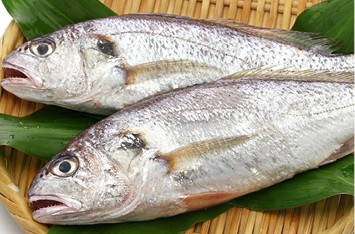
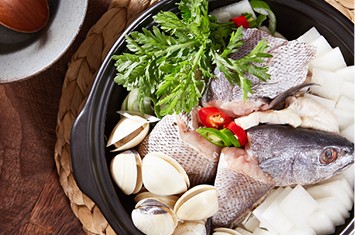
How to Make Eochae
Main ingredients Fish, starch, water parsley, green onion, black mushroom, hwanghwachae(seasoned day lily flower and stems), golden oak mushroom, stone mushroom, crown daisy, mother chrysanthemum leaves, omasum, tripe, end of cow intestine, lung, pheasant, pork, jumbo shrimp, sea cucumber, abalone, ginger, chili pepper, egg, young cucumber, bellflower root, seasoned vegetables, and soy sauce with vinegar
How to make it
① Cut the head of any fish, remove the intestines, peel it, and cut only the flesh.
② It can be cut lengthwise or into thick squares.
③ Dip the fish in starch, blanch it in boiling water, put it in cold water, and drain it on a strainer.
④ Cut the water parsley, head of green onion, black mushroom, hwanghwachae, golden oak mushroom, stone mushroom, crown daisy, mother chrysanthemum leaves, omasum, tripe, end of cow intestine, lung, pheasant, pork, jumbo shrimp, sea cucumber, abalone, ginger, chili pepper, egg garnish, and peeled young cucumber neatly, and coat them in starch. Cut the bellflower roots, dip them in yellow, blue, and pink water, and coat them in starch.
⑤ Blanch them separately, drain in cold water, and put them on a plate according to their colors.
⑥ When serving, mix fish meat and vegetables, garnish with eggs, stone mushroom, and red pepper, sprinkle with pine nuts, and eat it by dipping in vinegar.
How to Make Saengseonhoe(Sliced Raw Fish), Such as Croacker Hoe
<Joseon Moosang Sinsik Yori Jebeop> picks sliced raw croaker as the best raw fish to eat in June and July. It states that the taste of croakers caught before the end of June is the best in a year. It also advises to make hoe with fresh and fat fish to have good colored hoe that is suitable for the natures of many people. Moreover, it passes along a request to avoid making hoe with any fish that seems to be slightly spoiled. One of the two recipes is introduced here.
Main ingredients Fish, pine nut powder, makgeolli(unrefined rice wine), red chili paste with vinegar(mustard, salt, oil, and pepper), jinjang(mild soy sauce), radish, horseradish, ginger, green onion, and bokkeumgochujang(stir-fried red chili paste)
How to make it
① Look for the grain of the fish and slice it.
② Cut the fish finely, rub it in oil, and sprinkle pine nuts over it or slice it into 1/5 width of the fish. Place ice on a plate, cover it with a cloth, and place the sliced fish over it. It can also be soaked in makgeolli before use.
③ Eat it with cheonggukjang(sweet and sour red chili paste), mustard, or salt mixed with oil and pepper. Grind radish on a grater and put it in soy sauce, or grind the horseradish and eat it by dipping in the sauce, which offers a better flavor.
④ When serving hoe, present it in the shape of a flower or a mountain, and add fragrant grass on the side.
Tip Fish that are too large are not good for hoe because they have tendons. It is better to make it with medium-sized ones.Source: 《Joseon Moosang Sinsik Yori Jebeop》(by Lee Yonggi, Rice Tree)
How to Make Healthy Drinks for Summer
In quenching summer thirst, drinking healthy beverages is also very important. “Jehotang” and “Saengmaksan” are considered as the best summer nourishing drinks that protect your health. In the “Hwachae” part of <Joseon Moosang Sinsik Yori Jebeop>, it introduced a unique recipe for making “Kongguk”(chilled soybean soup) and “Gatguk”(chilled sesame soup) with iced water. In <How to Make Joseon Dishes> and <How to Make Korean Dishes>, the kongguk hwachae recipe is also introduced.
How to Make Jehotang
Method 1Main ingredients 1 geun(=about 600 g) of mume fruits, 2 bowls of water, 1/2 geun of amomum seeds, 5 geun of honey, 2 jeon(=about 7.5 g) of white sandalwood powder, and 1 ja(= about 30.3 cm) of muskHow to make it① Crush 1 geun of mume fruit flesh, pour 2 bowls of water, boil it, and let it settle clearly.
② Mix in 1/2 geun of amomum seeds into the mume juice, put it in a porcelain bowl together with 5 geun of honey, and boil until it turns reddish.
③ When cooled, add 2 jeon white sandalwood powder and 1 ja of musk.
Method 2Main ingredients 1 geun of mume fruits, 1 nyang(=about 37.3 g) of amomum medium, 5 jeon each of amomum seeds and white sandalwood, 5 geun of honey
How to make it① Grind 1 geun of mume fruits into powder.
② Finely grind 1 nyang of amomum medium, 5 jeon of amomum seeds, and 5 jeon of white sandalwood.
③ Add 5 geun of decocted honey, boil lightly, and stir evenly. Put in a porcelain bowl and drink it in cold water.
Source: <Salim Gyeongje>(Agricultural and Living Management)
How to Make Saengmaksan
Main ingredients 7.5g Big Blue Lilyturf, 3.75 g omija, 3.75 g ginseng
How to make it① Decoct the medicinal herbs in water and drink it instead of boiling water in summer.
② Sometimes 3.75 g each of milkvetch root and licorice are also added.
③ It can also be decocted with 0.75 g of phellodendron bark to give you more energy.
Source: 《Donguibogam》
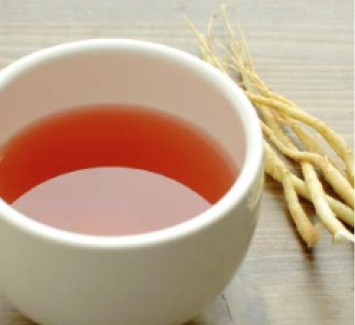
photo by <100 Ginseng Dishes>(by Rural Development Administration, thethinkbook)

How to Make Kongguk
Main ingredients Thick soybeans and ice
How to make it ① Wash the beans thoroughly, boil them, and grind them on a millstone.
② Squeeze them in a pouch, put a block of ice in it, and eat it. It has nutty and refreshing flavors.
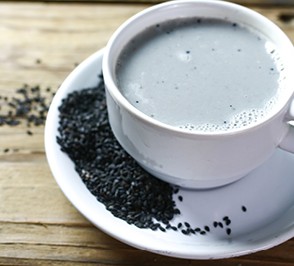
How to Make Gatguk
Main ingredients Sesame
How to make it ① Wash the sesame seeds thoroughly without stones. Remove their husks and make them like Kongguk.
② Drink it, eat it with noodles, or add stir-fried tripe and omasum.
③ It tastes good with all types of food.
Source: 《Joseon Moosang Sinsik Yori Jebeop》(by Lee Yonggi, Rice Tree)

 한국어
한국어
 English
English






